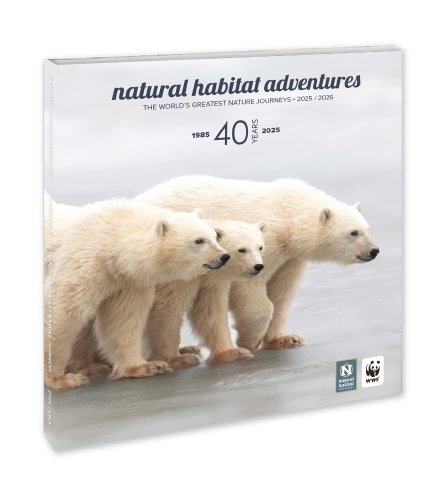By Nat Hab Expedition Leader Katrina Rosen
Stepping off the flight in Churchill, you may know you are still in North America, but it no longer feels like home. The bite of fresh air and the welcoming wind let us know we are in the north.
We arrive for the northern lights, excited to spend our evening beneath the vast sky to catch the dancing aurora borealis. It’s the middle of winter, in a wild place with no light pollution. The remote sites we go to are perfect for aurora viewing.
Yet, as an Expedition Leader lucky enough to be working with Natural Habitat Adventures on the edge of the Arctic—in both Churchill, Manitoba and Iceland—I can tell you that there is so much more to experience. We can find the Milky Way and Jupiter, learn about the phases of the moon, watch the International Space Station fly by, and follow the arc of Orion. The stars are, of course, endless.
Not only is the night sky filled with infinite wonders, but we have also stepped into a place with deep history and culture.

Inuit Inukshuk at Churchill’s Hudson Bay, photographed by Nat Hab Expedition Leader © Eddy Savage
Defining the Arctic
In current times, one can define the Arctic in several different ways, including climate, geography, ecology and culture. The Arctic Circle lies at the latitude 66°33′N. This latitude is significant because it is where the Earth experiences twenty-four hours of daylight on the summer solstice and twenty-four hours of darkness during the polar night of the winter solstice.
The temperature difference caused by these huge swings in daylight hours has dictated glacier cover or recession and heavily impacts plant growth. Harsh conditions have constrained ecosystem development, and at 66° latitude, the entire Arctic Circle lies beyond the tree line.
Despite the harsh conditions, humans have remarkably adapted to this region. The Arctic is home to four million people, including the Sami, Chukchi, Nenets, Kalaallit, Aleut and the Inuit. There are millions more if we include subarctic people, including those of Churchill, Manitoba. Archeological evidence supports that this is not a recent development—humans have lived and thrived in this environment for millennia.

Churchill Teepee, photographed by Expedition Leader © Eddy Savage
The Arctic’s Astronomical Wonders
When bygone civilizations stared up into the ether, they began to understand seasonal patterns of the constellations and individual stars. Shepherds, warriors, fishermen, slaves, priests and elders observed the sun, moon and stars following certain paths through the sky. Other astronomical wonders, like the planets, were first thought to be wandering stars, since they didn’t follow the same rhythm.
These findings by early astronomers led to the question, “Are we really the center of the universe?”
Sky Full of Bears
Our sky is woven with ancient mythology, and even the name ‘Arctic’ is deeply connected to the pinpricks of light above us, the constellations. This word is rooted in the Greek word Arktos, which means bear. (I love bears!) One of the most well-known circumpolar constellations that commands our attention is Ursa Major, The Great Bear.
If by chance you have not heard of Ursa Major, then you will know this famous asterism, the Big Dipper. The Big Dipper (or Plough) forms The Great Bear’s back and tail. Although many of the names we use now were formalized from Greek culture, for thousands of years prior, from Siberia to North America, people found this bear in the stars.

Boreal forest, photographed by Expedition Leader © Eddy Savage
Linguists have discovered that even Indo-European societies used bear-related terms to describe this constellation. Further east, petroglyphs depicting Ursa Major’s seven prominent stars were found near Lake Baikal and the Altai mountains, which led some scholars to believe the petroglyphs are bears.
In the north, Sami spirituality views the bear as a messenger between humans and the spirit world. The story of Ursa Major in Sami folklore describes hunters chasing a bear through the sky.
In North America, many Indigenous peoples have also shared stories in which the stars of Ursa Major represent a great bear being pursued by hunters. In Cree tradition the story unfolds as the constellation moves through the night sky over an entire year. The three stars in the handle of the Big Dipper are the hunters. One carries a bow and arrow, one carries a pot, and the third is often portrayed as slow, clumsy or young and lags behind the others.
In the spring, as the Big Dipper becomes more visible, the bear emerges from the den. All summer long, the hunters chase the bear across the sky. By autumn, the bear has been wounded, and blood begins to spill. It spills on the willows and maple trees. It stains the breast of the robin.

Photographed by Nat Hab Expedition Leader © Garrett Fache
For the Blackfeet people, the Big Dipper is a woman who was transformed into a bear. She was pursued by her brothers into the sky, where they became the asterism, the Big Dipper. The Arctic was the “land under the great bear” because of this incredible constellation.
More Stars & Constellations
But many other stars were important as well. Egyptians timed the heliacal rising of the brightest star we see, Sirius, with the annual flooding of the Nile River. This was seen as a symbol of rebirth and renewal of the land.
Babylonians and Mesopotamians timed the early dawn rising of the Pleiades star cluster, which is part of the constellation we call Taurus, to mark the arrival of spring—a signal to begin planting season. When the Pleiades, also now known as the Seven Sisters, became visible throughout the night, the Iroquois recognized it as a sign of the arrival of winter—a time to prepare for harsh winter conditions.
In contrast, when Leo (the lion constellation) is highest in the sky, this marks warm summer nights. The Algonquin knew this was a time for movement, gathering berries, and feasts.

Photographed from the Tundra Lodge by Nat Hab Staff © Megan Brief
The seasonal cadence of constellations was important to all life tied into the land. As the stars have different alignments during our lap around the sun, it could be a time for revival, preparation, agriculture or fertility. It may be a month for religious ceremonies or hunkering down.
The myths of the stars timed to the natural rhythms of Mother Earth. This was a way to mark seasonal changes within plant cycles, animal migration patterns and temperature changes. The stories became tools to pass down knowledge of timing, feeding oneself and survival.
And so, time has gone on from the Proto-Indo European (PIE) root word for bear to Arctos, to Ursa Major and Ursa Minor, to what we now call the Arctic. Interestingly, the subarctic, where Churchill, Manitoba and Iceland are located, means “below the region of the bear.”
Antarctica lies in the southern hemisphere at the other end of the poles, where neither Ursa Major nor Ursa Minor is visible. It is geographically and metaphorically titled “opposite of the bear.”

Nat Hab Expedition Leader © Eddy Savage
Chasing the Aurora
I find it fitting that we spend weeks in the winter chasing the northern lights in the Polar Bear Capital of the World. It feels meaningful to be near Ursa Maritimus, hunting out on the ice under the watchful presence of Ursa Major. For thousands of years, so many cultures have gazed at the stars of the Arctic sky and created stories inspired by animals that were significant to their environment and way of life. The bear symbolized kinship, just as it is still a major representation of our environment and the ways of the Arctic today.
The Arctic territories are claimed by eight different Arctic nations: the United States (Alaska), Denmark (Greenland), Finland, Iceland, Norway, Russia and Canada. It’s a complex place. The Arctic is certainly famous for its northern lights and its polar bears, but as you have read, it is well worth learning more. And, in my opinion, you can never spend enough hours beneath this beautiful sky.
I can’t wait to see you up there!
Explore the Arctic sky on Nat Hab’s Northern Lights & Arctic Exploration adventure.

Nat Hab Expedition Leader Katrina Rosen and Guest snowshoeing in the boreal forest. Photographed on our Northern Lights & Arctic Exploration: Women’s Journey by Nat Hab Staff © Megan Brief



























